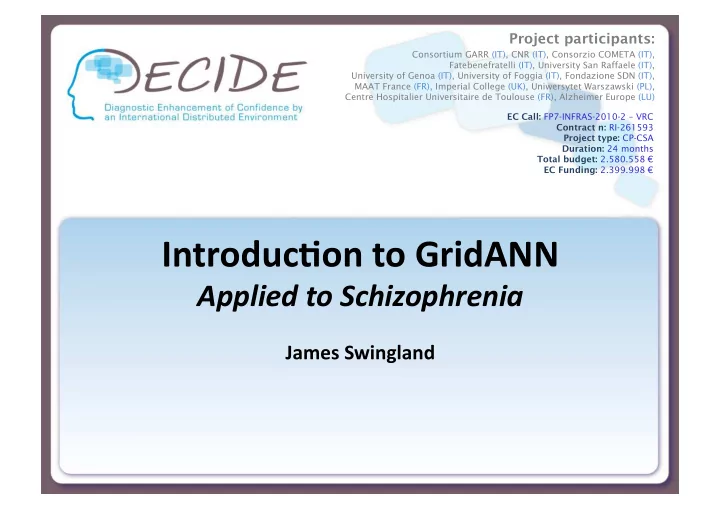

Project participants: Consortium GARR (IT), CNR (IT), Consorzio COMETA (IT), Fatebenefratelli (IT), University San Raffaele (IT), University of Genoa (IT), University of Foggia (IT), Fondazione SDN (IT), MAAT France (FR), Imperial College (UK), Uniwersytet Warszawski (PL), Centre Hospitalier Universitaire de Toulouse (FR), Alzheimer Europe (LU) EC Call: FP7-INFRAS-2010-2 – VRC Contract n: RI-261593 Project type: CP-CSA Duration: 24 months Total budget: 2.580.558 € EC Funding: 2.399.998 € Introduc)on to GridANN Applied to Schizophrenia James Swingland
Schizophrenia • Compared with Alzheimer's disease biomarkers for psychiatric disorders such as Schizophrenia are poorly developed/defined – Diagnosis uses clinical features (WHO, DSM‐IV) • More complex analysis techniques are therefore needed to get suitable measures out of the available data • Schizophrenia is associated with increased dopamine synthesis in the striata • Use ArMficial Neural Networks (ANN) to use analyse dopamine acMvity measured using Positron Emission Tomography (PET)
What is an ANN ? • ArMficial Neural Networks are a way to analyse data using computers. • ANN learns how to disMnguish controls from paMents ('simulated brain') • Marker values from subjects are put into the ‘black box’ ANN and a “classificaMon” is returned.
Positron Emission Tomography Inject 6‐[18F] fluoro‐l‐DOPA ([18F]‐DOPA) radiotracer to measure dopamine synthesis in brain – greater amounts of dopamine in striata in the schizophrenic brain • Differences not enough by themselves to classify individual paMents usefully
Basic Scheme • Acquire images using PET scanner • Reconstruct and correct image • Model [18F]‐DOPA data using Bayesian wavelets approach ( to be implemented on the grid ) • Normalise paMent into template space and extract region of interest (ROI) data from striata • Put ROI values into ANN and obtain indicaMon of disease state
PET Scan • 1hr before the scan give subjects signal enhancing drugs – 150 mg of carbidopa – 400 mg of entacapone • Record and aeempt to minimise head movement • [18F]‐DOPA acMvity 102‐135 MBq • Scans should have the following frame Mmes – 30s background frame, followed by 4 x 60s, 3 x 120s, 3 x 180s & 15 x 300s
Preprocessing • Reconstruct dynamic PET image using – iteraMve methods if available – standard filtered back projecMon if not • Apply aeenuaMon correcMon • Apply post‐hoc frame by frame realignment to correct for movement
Kine)c Modelling • Best method currently mulM‐resoluMon Bayesian modelling to the dynamic PET scan – Other kineMc methods can be applied, but provide higher noise levels • Bayesian modelling Currently available as free MATLAB script (“ piwave ”) – To be implemented on the DECIDE grid.
Kine)c Modelling • Sejngs for MulM‐resoluMon wavelet modelling are preselected and opMmised for the correct scan protocol – Also performs decay correcMon • Needs the following file types – Dynamic scan image (Analyze 7.0 format) – Cerebellum Time acMvity curves (IDWC file format) or arterial input funcMon
Normalisa)on • Subject images must be normalised into standard space – (bounding box 91 x 109 x 91, 2mm x 2mm x 2mm voxels) • NormalisaMon occurs using standard non‐linear registraMon (e.g. SPM or gridSPM ) • Normalise PET images to FDOPA template • Visually inspect images to make sure normalisaMon has occurred correctly
Region of Interest values • Regions are defined in MNI space • The lem and right striata are each split into ROI – 6mm slices on the lem and right striata • Average [18F]‐DOPA uptake (Ki) values are extracted for each of the 12 ROIs, (6 lem, 6 right) • ROIs are combined (lem over right) to give measures of the laterality of FDOPA acMvity. Paeerns in this disMnguish schizophrenics from normal people
ANN STEP • Pre‐trained ANN takes the ROI data and converts it into a diagnosis. • Neural network has already learnt how to disMnguish the groups based on pre‐exisMng data • Grid hides implementaMon and paMent details sejngs hidden from users
Using the service • Currently ANN component is implemented – Extracts ROI automaMcally from normalised image – Users must upload normalised parametric (Ki) maps • Image files uploaded to ANN in Analyze 7 format. Analyze format is made up of two files which must have the same name (different extensions) – Image file ('.img') – Header file ('.hdr')
Interface
Output • Currently output is a binary value – “1”, means that the ANN classifies the subject as a paMent – “0”, means that the ANN classifies the subject as a control • Future output may include images/plots of overall [18F]‐DOPA acMvity if there is user demand • ANN should not be relied on for a diagnosis, but may be of use in helping difficult diagnosis
Recommend
More recommend